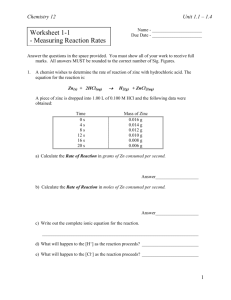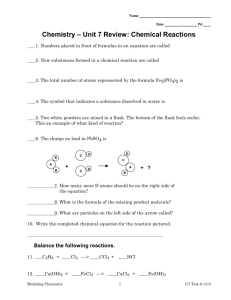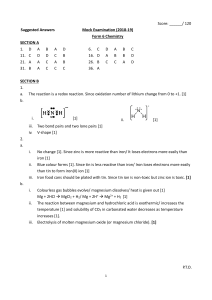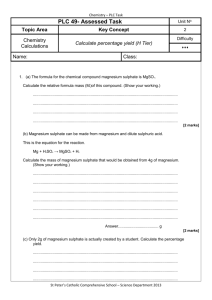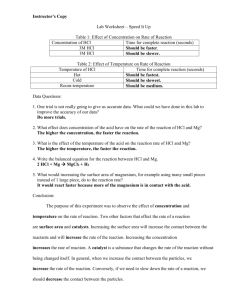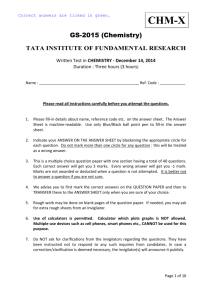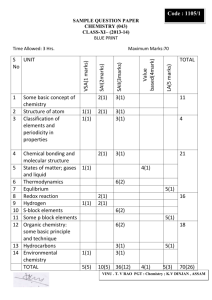Worksheet 1-1 - Measuring Reaction Rates
advertisement
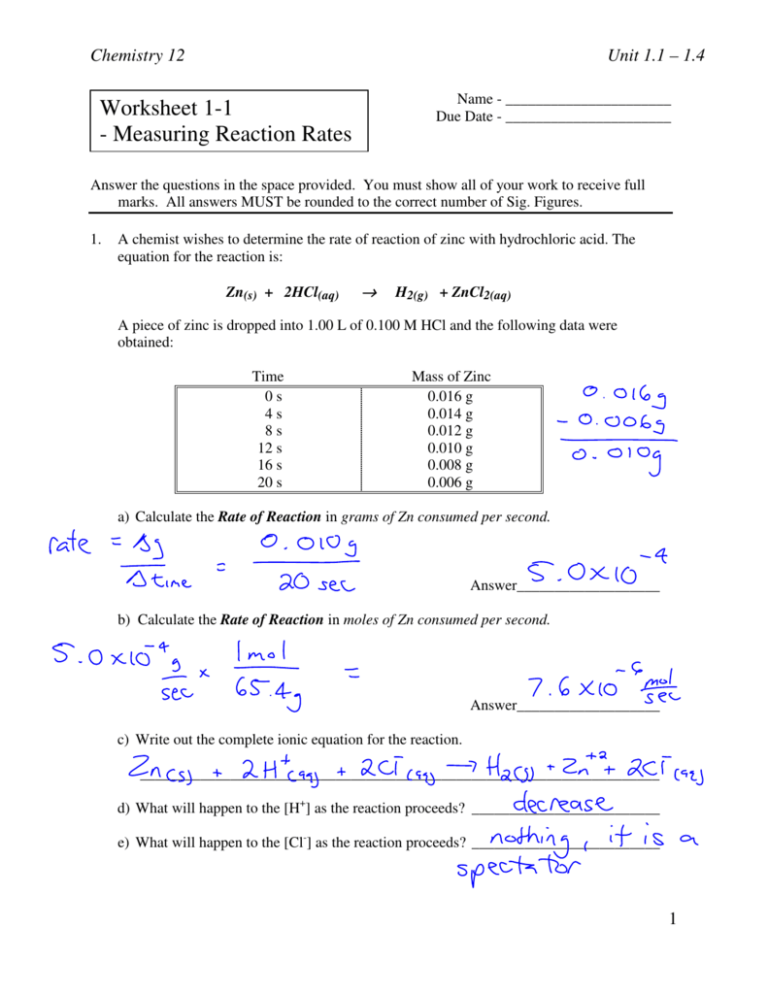
Chemistry 12 Unit 1.1 – 1.4 Name - ______________________ Due Date - ______________________ Worksheet 1-1 - Measuring Reaction Rates Answer the questions in the space provided. You must show all of your work to receive full marks. All answers MUST be rounded to the correct number of Sig. Figures. 1. A chemist wishes to determine the rate of reaction of zinc with hydrochloric acid. The equation for the reaction is: Zn(s) + 2HCl(aq) → H2(g) + ZnCl2(aq) A piece of zinc is dropped into 1.00 L of 0.100 M HCl and the following data were obtained: Time 0s 4s 8s 12 s 16 s 20 s Mass of Zinc 0.016 g 0.014 g 0.012 g 0.010 g 0.008 g 0.006 g a) Calculate the Rate of Reaction in grams of Zn consumed per second. Answer___________________ b) Calculate the Rate of Reaction in moles of Zn consumed per second. Answer___________________ c) Write out the complete ionic equation for the reaction. _____________________________________________________________________ d) What will happen to the [H+] as the reaction proceeds? _________________________ e) What will happen to the [Cl-] as the reaction proceeds? _________________________ 1 Chemistry 12 2. Unit 1.1 – 1.4 When magnesium is reacted with dilute hydrochloric acid (HCl), a reaction occurs in which hydrogen gas and magnesium chloride is formed. a) Write a balanced formula equation for this reaction. _____________________________________________________________________ b) If the rate of consumption of magnesium is 5.0 x 10-9 mol/s, find the mass of Mg consumed in 5.0 minutes. Answer___________________ 3. Given the reaction: CO2(g) + NO (g) colourless → CO(g) colourless + colourless NO2(g) brown Suggest a method which could be used to monitor the rate of this reaction. Why wouldn’t total pressure be a good way to monitor the rate of this reaction? 4. Equal volumes of Fe2+(aq) and C2O42-(aq) are individually reacted with 0.10 M MnO4-(aq), and the following data were obtained: Reactant Fe2+ C2O42- Concentration Temperature Time for complete reaction 0.20 M 25°C 1.6 s 0.40 M 35°C 17.0 s Explain in detail why these results are obtained. 2 Chemistry 12 Unit 1.1 – 1.4 5. Given the reaction: explain why this reaction is very slow at room temperature. 6. (1 mark) On the following set of axes, draw the shape of the curve you would expect if you plotted the [HCl] vs. Time, starting immediately after the two reactants are mixed. The equation for the reaction is: Mg(s) + 2HCl(aq) → H2(g) + MgCl2(aq) [HCl] Explain how you got that particular shape. Be detailed. Time 7. Given the reaction: CO2(g) + NO(g) CO(g) + NO2(g) , sketch the shapes of the curves on the following graphs assuming that some CO2 and NO is placed in a closed container and left to react. (2 marks) [NO2 [CO2 time time 3 Chemistry 12 Unit 1.1 – 1.4 8. Given the following reaction and graph: a) Calculate the average rate of reaction in mL CO2 /min for the time interval 0 – 2 min. (2 marks) Answer _______________ b) Calculate the average rate of reaction in mL CO2 /min for the time interval 2 – 4 min. (2 marks) Answer _______________ c) Explain why the rate in (b) is less than the rate in (a) (1 mark) 9. Given the reaction: Sn(s) + 2 HCl(aq) H2(g) + SnCl2(aq) Give 4 methods by which the rate of this reaction could be increased (4 marks) 4 Chemistry 12 Unit 1.1 – 1.4 10. The following table relates the time and the mass of Zn during the reaction between Zn and 0.5M HNO3 : Zn(s) + 2HNO3 (aq) Time 0.0 s 60.0 s 120.0 s 180.0 s → H2(g) + Zn(NO3)2(aq) Mass of Zn (g) 36.2 g 29.6 g 25.0 g 22.0 g a) Calculate the reaction rate, in g/s, from time 0 to 60 s. b) Calculate the reaction rate, in g/s, from time 120s to 180 s. c) Explain why the rate in calculation "b" is less than that of calculation "a". 11. Give two reasons why water is effective at putting out fires. Use concepts learned in this unit so far. _____________________________________________________________________ _____________________________________________________________________ 12. Consider the rate of the following reaction: Fe(s) + 2HCl(aq) → H2(g) + FeCl2(aq) a) Is rate dependent on temperature? ____________________. Explain your answer. _____________________________________________________________________ b) Is rate dependent on pressure? ___________________. Explain your answer. _____________________________________________________________________ c) Is rate dependent on surface area? ___________________. Explain your answer. _____________________________________________________________________ 5 Chemistry 12 Unit 1.1 – 1.4 13. Consider the rate of the following reaction: 2NaOCl(aq) → 2NaCl(aq) + O2(g) a) Is rate dependent on temperature? ____________________. Explain your answer. _____________________________________________________________________ b) Is rate dependent on pressure? _______________________. Explain your answer. ______________________________________________________________________ c) Is rate dependent on surface area? ____________________. Explain your answer. _____________________________________________________________________ c) Is rate dependent on [NaOCl]? _______________________. Explain your answer. _____________________________________________________________________ 6
